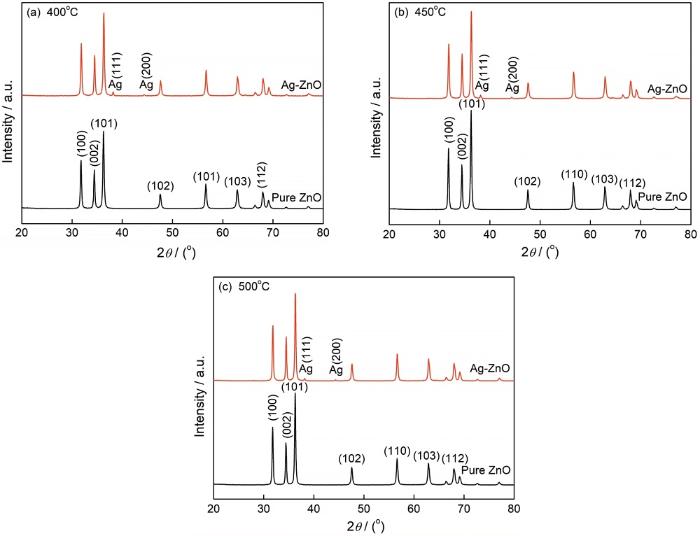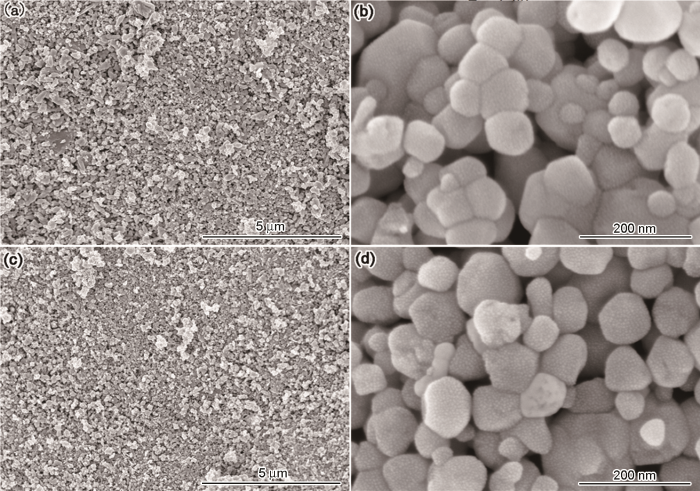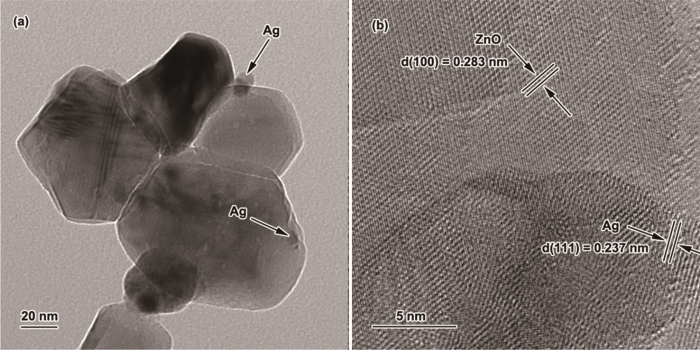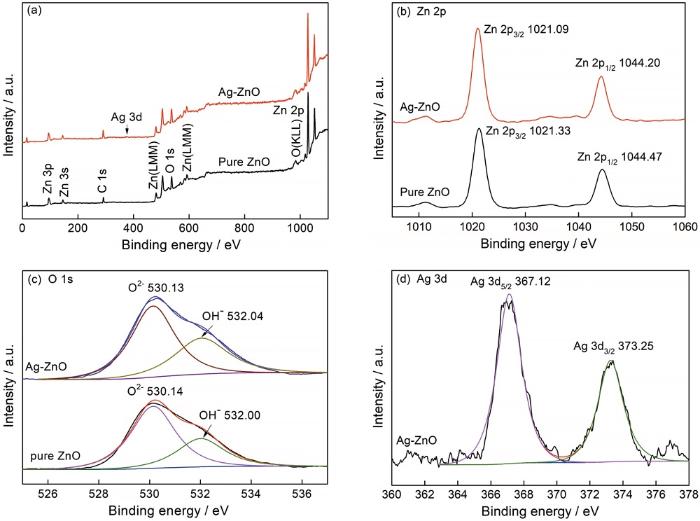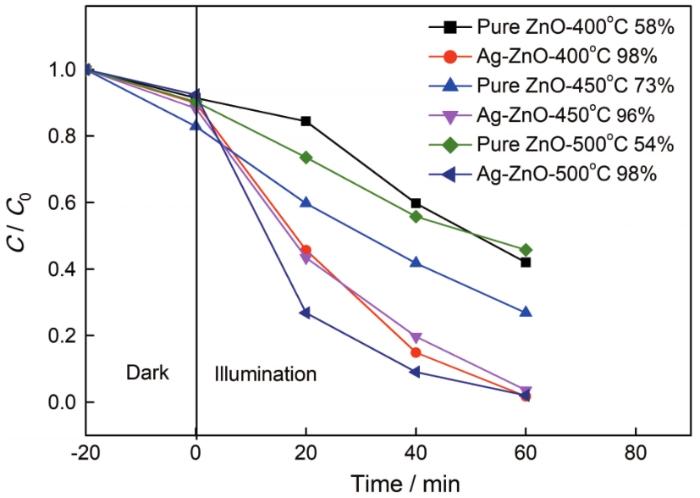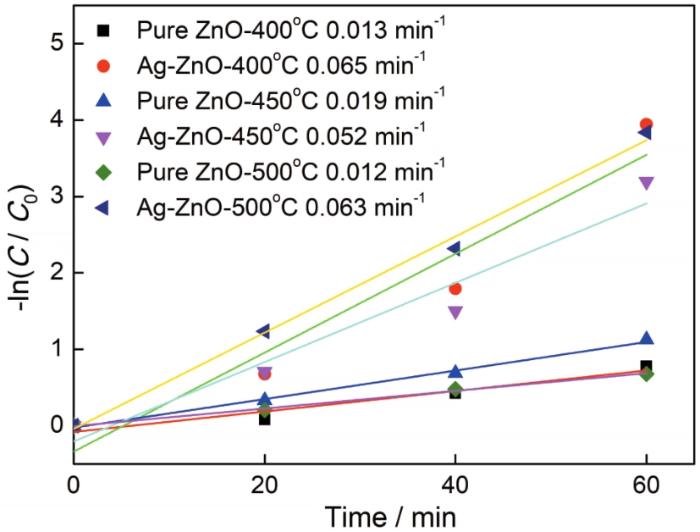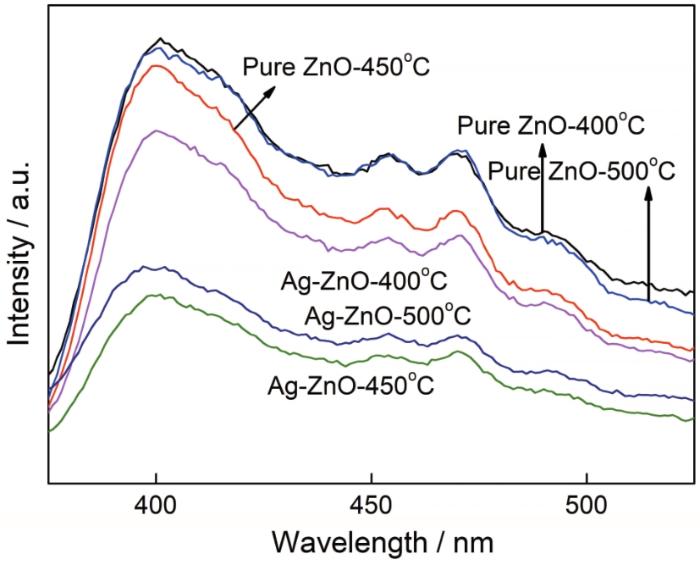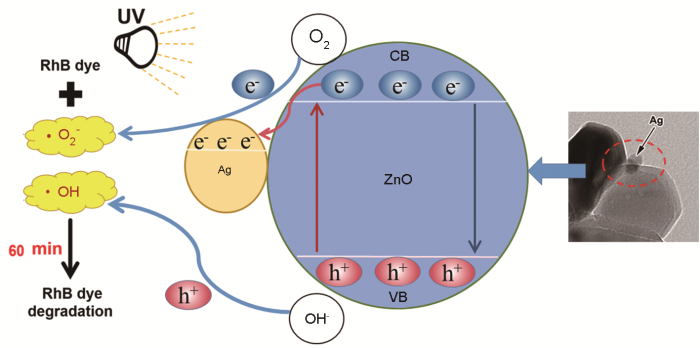1 实验方法
1.1 样品的制备
将100 mL无水乙醇(CH3CH2OH)、60 mL去离子水(H2O)、6 mL二乙醇胺(DEA)和13.2 g乙酸锌(Zn(CH3COO)2·2H2O)加入烧杯中,将其在70℃水浴加热条件下搅拌120 min,然后放置在阴暗处陈化即得到ZnO凝胶。将ZnO凝胶在90℃恒温干燥箱中干燥48 h,得到ZnO干凝胶。将ZnO干凝胶研磨,分别在400℃、450℃、500℃保温2 h,将产物再次研磨得到纯ZnO粉体。
在烧杯中加入适量的AgNO3,使Ag/Zn原子比为1%,然后将其按照以上步骤操作即制得Ag修饰的ZnO,为方便将1%Ag修饰ZnO记为Ag-ZnO。
1.2 性能表征
使用DX-2700型X射线衍射仪(XRD) 分析样品的晶体结构;用FEI-Inspect F50型扫描电子显微镜(SEM)和FEI-Tecnai G2 F20型透射电子显微镜(TEM)观测样品的形貌;用XSAM800型多功能表面分析系统(XPS) 分析元素组成和价态;用F-4600型荧光光谱仪进行荧光光谱(PL)分析;使用V-sorb 2800S比表面分析仪测试样品的比表面积。
将0.25 g样品粉体加入罗丹明B(RhB)水溶液(250 mL, 10 mg/L)中,暗态搅拌20 min以保证催化剂与RhB分子之间达到吸附脱附平衡,以测试其光催化活性。在250 W高压汞灯照射下继续搅拌,每隔20 min取样一次。将样品离心分离后取上层清液,使用UV-6100A型紫外可见分光光度计测定其在553 nm处的吸光度,RhB降解率为(A0-At)/A0,其中A0、At分别为光催化反应0 min和t min时溶液的吸光度。
2 结果和讨论
2.1 XRD分析
图1a、b、c分别给出了纯ZnO和Ag-ZnO在400℃、450℃、500℃热处理后的XRD图谱。可以看出,纯ZnO的衍射峰分别出现在2θ=31.8°、34.4°、36.2°、47.5°、56.6°、62.8°,67.9° 附近,分别对应于ZnO六方晶相(100)、(002)、(101)、(102)、(110)、(103)、(112)晶面,表明纯ZnO具有六方晶系纤锌矿结构[10]。Ag-ZnO与纯ZnO衍射峰的位置形状基本相同,表明Ag-ZnO也具有六方晶系纤锌矿结构。在Ag-ZnO图谱中除了ZnO的衍射峰外,还在38.1°、43.3°处出现了衍射峰,对应单质Ag的(111)、(200)晶面,表明Ag-ZnO样品中有单质Ag。根据Scherrer公式[6]计算样品的晶粒尺寸,可知纯ZnO400℃、450℃、500℃的晶粒尺寸分别为28.1 nm、31.9 nm、30.8 nm;Ag-ZnO400℃、450℃、500℃的晶粒尺寸分别为29.6 nm、30.0 nm、31.4 nm。结果表明,热处理温度和Ag修饰对晶粒尺寸的影响都很小。
图1
2.2 纯ZnO和Ag-ZnO的形貌
图2分别给出了在500℃热处理的纯ZnO(a、b)和Ag-ZnO(c、d)的SEM照片,其中(a)、(c)放大倍数1万倍,(b)、(d)放大倍数20万倍。从图中可见,纯ZnO颗粒类似球形,单颗颗粒尺寸大概为30~100 nm。Ag-ZnO颗粒的形貌与纯ZnO形貌几乎相同,颗粒尺寸也没有明显的变化。这表明,Ag修饰对ZnO颗粒的形貌影响不大。
图2
图2
在500℃热处理后纯ZnO 和Ag-ZnO的SEM照片
Fig.2
SEM images of pure ZnO (a, b) and Ag-ZnO (c, d) annealed at 500℃
图3
图3
在500℃热处理后 Ag-ZnO 的TEM照片和HRTEM照片
Fig.3
TEM (a) and HRTEM (b) images of Ag-ZnO annealed at 500℃
2.3 XPS分析
图4给出了在500℃处理的纯ZnO和Ag-ZnO 的XPS图谱。全谱图(a)中纯ZnO出现Zn、O 、C 3种元素衍射峰,其中C元素可能来源于油污染物。在Ag-ZnO图谱中还有Ag 3d峰出现,表明Ag元素存在于样品中。图4b给出了样品Zn 2p高分辨图谱,纯ZnO中的峰位于1021.33 eV和1044.47 eV处,分别对应于Zn 2p3/2和Zn 2p1/2,Ag-ZnO图谱中Zn 2p3/2和Zn 2p1/2峰位于1021.09 eV和1044.20 eV。纯ZnO与Ag-ZnO的Zn 2p3/2和Zn 2p1/2峰之间的能量差约为23 eV,表明样品中Zn离子的氧化态为+2[16]。图4c给出了O 1s高分辨图谱,在纯ZnO中位于530.14 eV和532.00 eV的峰分别对应着晶格氧(O2-)和表面羟基(OH-)[15];Ag-ZnO图谱中晶格氧(O2-)和表面羟基(OH-)分别位于530.13 eV和532.04 eV。在光催化过程中,OH-与光生空穴发生反应,生成氢氧自由基(•OH),•OH具有强氧化性,能将有机分子分解为无机小分子从而降解有机物[17]。因此,OH-的含量越高越有利于光催化降解。有研究表明,离子掺杂改性后光催化剂表面OH-的含量提高[18]。但是,Jiang等[19]的研究结果表明,掺杂N元素和La元素使光催化剂表面OH-的含量降低。本文的纯ZnO中OH-所占O元素比例为32.4%,Ag-ZnO中OH-所占O元素比例为37.7%,表明Ag修饰后有利于提高OH-含量,这与文献[18]的结果一致。图4d给出了Ag 3d高分辨图谱,图中位于367.12 eV和373.25 eV的两个峰分别对应Ag 3d5/2和Ag 3d3/2,表明该样品中Ag以单质存在[1],也与XRD、TEM的测试结果相符。
图4
图4
在500℃热处理后纯ZnO和Ag-ZnO的 XPS图谱
Fig.4
XPS spectra of pure ZnO and Ag-ZnO annealed at 500℃
2.4 光催化性能
图5
图5
纯ZnO和Ag-ZnO对RhB的降解率曲线
Fig.5
Degradation rate curves of RhB for pure ZnO and Ag-ZnO
ZnO光降解RhB的反应属于一级反应,根据公式ln(C/C0)=-kt可计算其反应速率常数[21],其中k为一级反应速率常数,t为反应时间,C、C0分别为反应t min后与反应开始时的RhB浓度。纯ZnO与Ag-ZnO对RhB的光降解动力学曲线,如图6所示。图中直线的斜率越大,表示样品的降解速率越高[21]。在400℃、450℃、500℃热处理的纯ZnO其反应速率常数分别为0.013 min-1、0.019 min-1、0.012 min-1,其中在450℃热处理的样品反应速率最高,与降解曲线的结果一致。在400℃、450℃、500℃热处理的Ag-ZnO其反应速率常数分别为0.065 min-1、0.052 min-1、0.063 min-1,表明Ag的加入使ZnO的反应速率明显提高。
图6
图6
纯ZnO和Ag-ZnO对RhB的光降解动力学曲线
Fig.6
Photodegradation kinetics curves of pure ZnO and Ag-ZnO on RhB
图7
图8
图8
Ag-ZnO的光催化降解RhB示意图
Fig.8
Schematic diagram of photocatalytic degradation of RhB by Ag-ZnO
比表面积是影响ZnO光催化活性的重要因素之一。比表面积越大,越有利于光源的吸收和提供更多的反应点位。但是,关于Ag修饰对ZnO比表面积的影响存在争议。有报道表明,Ag修饰ZnO能增大其比表面积[24~26],但在Georgekutty等[27]的研究中,Ag修饰ZnO的比表面积小于纯ZnO,Sampaio等[23]发现,Ag修饰后比表面积基本不变。这可能与不同的合成方法和工艺有关。本文根据BET理论对氮气吸附脱附数据进行了比表面积测试,结果表明:在500℃热处理的纯ZnO和Ag-ZnO的比表面积分别为14.3 m2·g-1和 14.2 m2·g-1,可见Ag修饰对ZnO的比表面积影响不大,与文献[23]的结果一致。
3 结论
用Ag修饰ZnO,Ag颗粒以单质的形成沉积在ZnO表面,形成了Ag-ZnO异质结构。热处理对纯ZnO的光催化性能有较大的影响,但是对Ag-ZnO光催化性能的影响不大。在450℃热处理后纯ZnO的光催化性能最好。Ag-ZnO活性优于纯ZnO,因为Ag-ZnO异质结构降低了光生电子与空穴的复合并提高了OH-的含量。
参考文献
Effect of Ag shapes and surface compositions on the photocatalytic performance of Ag/ZnO nanorods
[J].
Hydrothermal synthesis and photocatalytic activity of CuO/ZnO composite photocatalyst
[J].
CuO/ZnO复合光催化剂的制备和性能
[J].
Preparation and photocatalytic properties of TiO2-ZnO composite hollow microspheres
[J].
TiO2-ZnO复合中空微球的制备及光催化性能
[J].
ZnO/Pt core-shell nanorods on the cotton threads with high enhanced photocatalytic properties
[J].
The influence of noble metals on photocatalytic activity of ZnO for Congo red degradation International
[J].
Enhanced photocatalytic activity of Au-doped Au@ZnO core-shell flower-like nanocomposites
[J].
Preparation of Ag/ ZnO composite hollow material and photocatalytic degradation for Rhodamine B
[J].
Ag/ZnO复合中空材料的制备及光催化降解罗丹明B
[J].
Preparation and photocatalytic performance of porous ZnO microrods loaded with Ag
[J].
Commercial ZnO and its hybrid with Ag nanoparticles: Photocatalytic performance and relationship with structure
[J].
Solvothermal synthesis of Ag/ZnO and Pt/ZnO nanocomposites and comparison of their photocatalytic behaviors on dyes degradation
[J].
Facile synthesis of the flower-like ternary heterostructure of Ag/ZnO encapsulating carbon spheres with enhanced photocatalytic performance
[J].
Synthesis of mesoporous Ag/ZnO nanocrystals with enhanced photocatalytic activity
[J].
Preparation, photocatalytic properties and mechanism of Fe or N-doped Ag/ZnO nanocomposites
[J].
In situ formation of Ag/ZnO heterostructure arrays during synergistic photocatalytic process for SERS and photocatalysis
[J].
Synthesis of spherical Ag/ZnO heterostructural composites with excellent photocatalytic activity under visible light and UV irradiation
[J].
Effect of Ag loading on activated carbon doped ZnO for bisphenol A degradation under visible light
[J].
Enhanced piezo/solar-photocatalytic activity of Ag/ZnO nanotetrapods arising from the coupling of surface plasmon resonance and piezophototronic effect
[J].
Synthesis and characterization of Ag doped TiO2 heterojunction films and their photocatalytic performances
[J].
Synergetic effects of lanthanum, nitrogen and phosphorus tri-doping on visible-light photoactivity of TiO2 fabricated by microwave-hydrothermal process
[J].
High UV-photocatalytic activity of ZnO and Ag/ZnO synthesized by a facile method
[J].
Synthesis of porous structured ZnO/Ag composite fibers with enhanced photocatalytic performance under visible irradiation
[J].
Facile photochemical synthesis of hierarchical cake-like ZnO/Ag composites with enhanced visible-light photocatalytic activities
[J].
Ag-loaded ZnO materials for photocatalytic water treatment
[J].
Facile synthesis of ZnO/Ag nanocomposites with enhanced photocatalytic properties under visible light
[J].
Novel ZnO-Ag/MWCNT nanocomposite for the photocatalytic degradation of phenol
[J].
Enhanced photocatalytic activity of Ag-ZnO nanoparticles synthesized by using Padina gymnospora seaweed extract
[J].
A highly efficient Ag-ZnO photocatalyst: synthesis, properties, and mechanism
[J].




